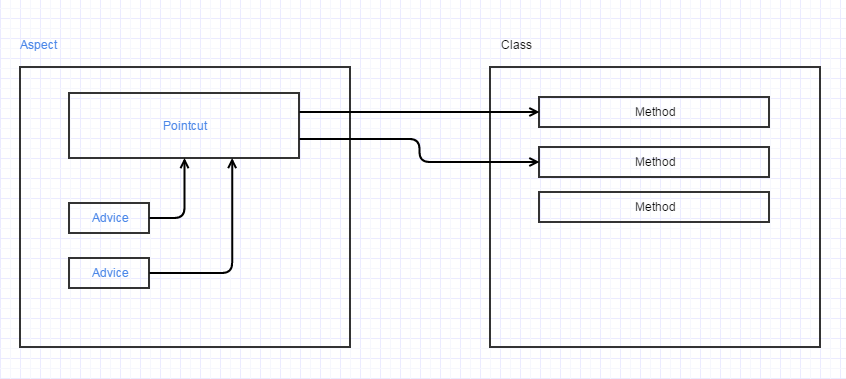Spring - AOP
Aspect Oriented Programming (AOP, 面向切面编程) compliments OOPs in the sense that it also provides modularity. But the key unit of modularity is aspect than class.
Why use AOP
利用AOP可以对业务逻辑的各个部分进行隔离,从而使得耦合度降低,提高程序的可重用性,便于对不同模块进行修改,也提高了开发效率。
Where use AOP
- 日志记录
- 性能统计
- 安全控制
- 事务处理
- 异常处理
AOP 原理
两种:
- 通过预编译方式
- 运行期动态代理
两者比较:
- AspectJ在编译时就增强了目标对象,Spring AOP的动态代理则是在每次运行时动态的增强,生成AOP代理对象。区别在于生成AOP代理对象的时机不同。
- 相对来说AspectJ的静态代理方式具有更好的性能,但是AspectJ需要特定的编译器进行处理,而Spring AOP则无需特定的编译器处理。
使用AspectJ在编译时修改class文件
原理:在编译阶段,在切面上,使用AOP代理类替换原有的类。
使用Spring AOP并采用动态代理的模式
- JDK动态代理:通过”接口”的方式实现动态代理
- CGLIB动态代理:通过”继承”的方式实现动态代理
Spring AOP - API
- Cross-Cutting Concern
- Aspect:类似于Java的类声明,包含了pointcuts和advice
- Joint point:表示程序中的某个位置,比如方法调用,对类成员的访问等
- Pointcut:表示一组joint point,定义了advice将要发生的地方
- Advices:定义了具体要做的操作
Cross-Cutting Concern
A concern that can affect the whole application and should be centralized in one location in code as possible, such as authentication, logging, security etc.
Aspect
It is a class that contains advices, joinpoints etc.
@Aspect
public class TrackOperation{...}
Join Point
Join Point is just a concept telling the program “at this point, I need some advices!” It does not have “Annotaion”.
Join point is any point in your program such as method execution, exception handling, field access etc. Spring supports only method execution join point.
Pointcut
Pointcut tells the program to select some join points and apply advices
It is an expression language of AOP that matches join points.
@Pointcut("execution(* Operation.*(..))")
public void myPointcut(){}//pointcut name
Advices
Advice represents an action taken by an aspect at a particular join point. There are different types of advices:
- Before Advice: it executes before a join point.
- After Returning Advice: it executes after a joint point completes normally.
- After Throwing Advice: it executes if method exits by throwing an exception.
- After (finally) Advice: it executes after a join point regardless of join point exit whether normally or exceptional return.
- Around Advice: It executes before and after a join point.
@Before("myPointcut()") //applying 'before advice' on this pointcut
public void myadvice(JoinPoint jp) //it is the advice
{
System.out.println("additional concern");
System.out.println("Method Signature: " + jp.getSignature());
}
Spring AOP - in Action
step 1: choose a class/joint point that needs advice
public class Operation{
public int m(){System.out.println("m method invoked");return 1;}
public int k(){System.out.println("k method invoked");return 2;}
}
step 2: write the Aspect class, telling where and what
- Pointcut: where to apply advices
- Advice: what to do
@Aspect
public class TrackOperation{
@Pointcut("execution(* Operation.*(..))")
public void myPointcut(){}
@Before("myPointCut()")
public void myadvice(JoinPoint jp)
{
System.out.println("additional concern");
}
}
step 3: add beans in applicationContext.xml
<?xml version="1.0" encoding="UTF-8"?>
<beans xmlns="http://www.springframework.org/schema/beans"
xmlns:xsi="http://www.w3.org/2001/XMLSchema-instance"
xmlns:aop="http://www.springframework.org/schema/aop"
xsi:schemaLocation="http://www.springframework.org/schema/beans
http://www.springframework.org/schema/beans/spring-beans.xsd
http://www.springframework.org/schema/aop
http://www.springframework.org/schema/aop/spring-aop.xsd">
<bean id="opBean" class="com.javatpoint.Operation"></bean>
<bean id="trackMyBean" class="com.javatpoint.TrackOperation"></bean>
<bean class="org.springframework.aop.aspectj.annotation.AnnotationAwareAspectJAutoProxyCreator"></bean>
</beans>
step 4: when use the “Operation” bean’s method in the app, advices will be applied

